belt OLDSMOBILE BRAVADA 1998 User Guide
[x] Cancel search | Manufacturer: OLDSMOBILE, Model Year: 1998, Model line: BRAVADA, Model: OLDSMOBILE BRAVADA 1998Pages: 380, PDF Size: 19.2 MB
Page 26 of 380
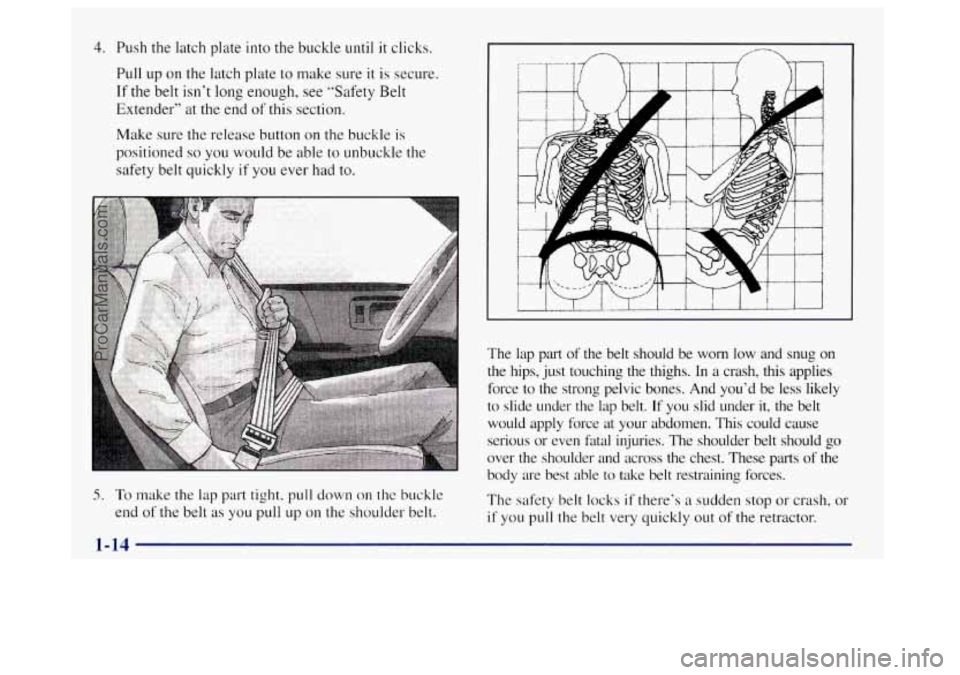
4. Push the latch plate into the buckle until it clicks.
Pull up
on the latch plate to make sure it is secure.
If the belt isn’t long enough, see “Safety Belt
Extender” at the end of this section.
Make sure the release button
on the buckle is
positioned
so you would be able to unbuckle the
safety belt quickly if you ever had to.
5. To make the lap part tight, pull down on the buckle
end
of the belt as you pull up on the shoulder belt. The lap part
of the belt should be
worn low and snug on
the hips, just touching the thighs. In a crash, this applies
force to the strong pelvic bones. And you’d be less likely \
to slide under the lap belt.
If you slid under it, the belt
would apply force at your abdomen. This could cause serious or even fatal injuries. The shoulder belt should
go
over the shoulder and across the chest. These parts of the
body are best able to take belt restraining forces.
The safety belt
locks if there‘s a sudden stop or crash, or
if you pull the belt very quickly out of the retractor.
1-14
ProCarManuals.com
Page 27 of 380
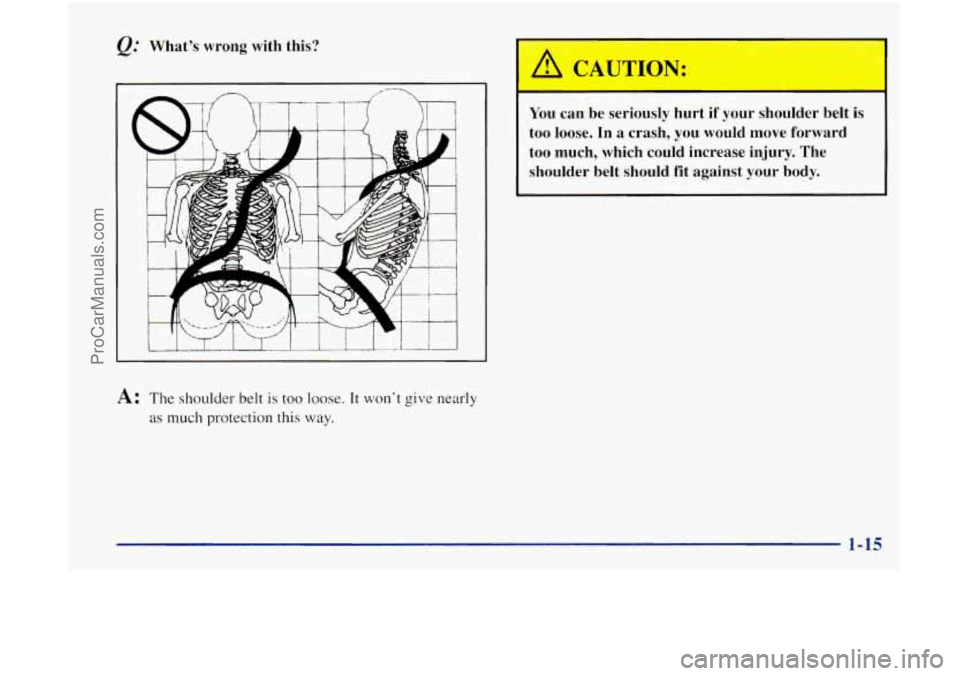
What’s wrong with this?
You can be seriously hurt if your shoulder belt is
too loose. In a crash, you would move forward
too much, which could increase injury. The
shoulder belt should fit against your body.
A: The shoulder belt is too loose. It won’t give nearly
as much
protection this way.
1-15
ProCarManuals.com
Page 28 of 380
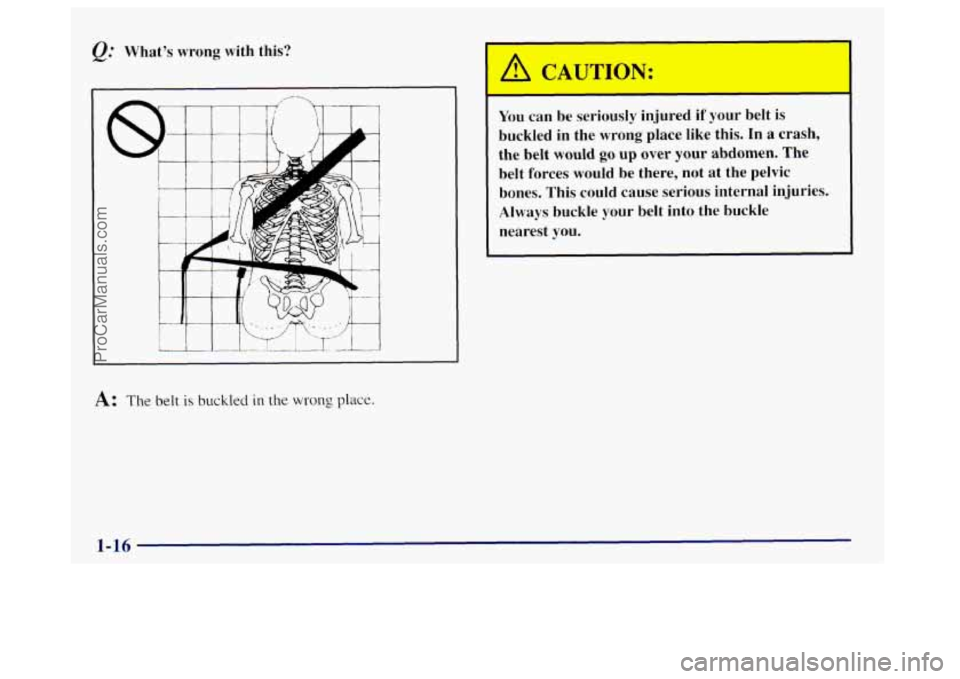
What's wrong with this?
A: The belt is buckled in the wrong place.
You can be seriously injured if your belt is
buckled in the wrong place like this.
In a crash,
the belt would
go up over your abdomen. The
belt forces would be there, not at the pelvic
bones. This could cause serious internal injuries.
Always buckle your belt into the buckle
nearest you.
1-16
ProCarManuals.com
Page 29 of 380
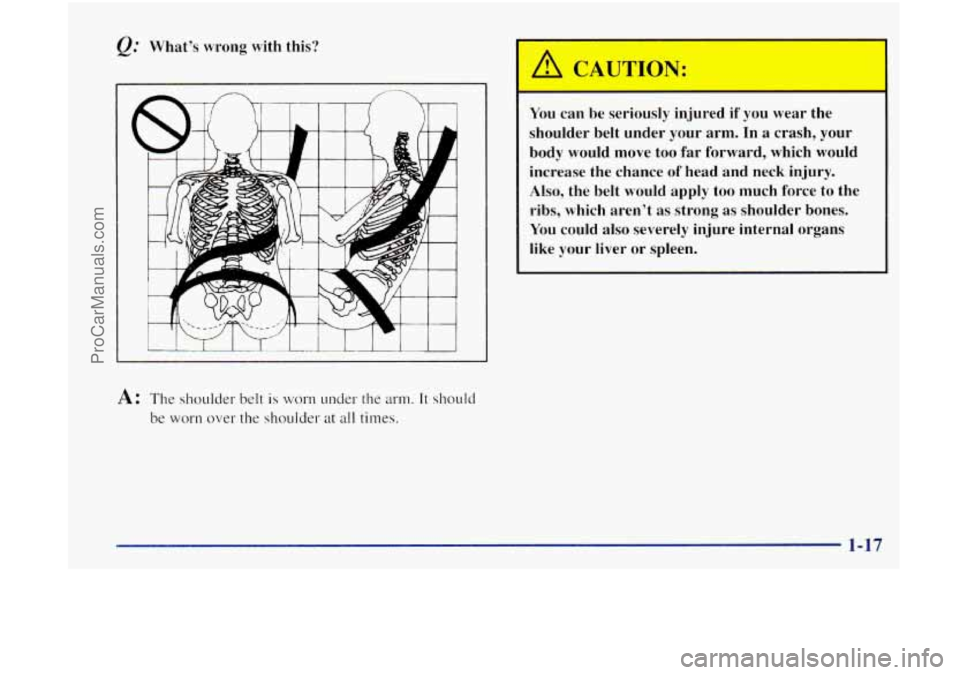
What’s wrong with this?
A: The shoulder belt is worn under the arm. It should
be worn over the shoulder at all times.
You can be seriously injured if you wear the
shoulder belt under your arm. In a crash, your
body would move
too far forward, which would
increase the chance of head and neck injury.
Also, the belt would apply too much force to the
ribs, which aren’t
as strong as shoulder bones.
You could also severely injure internal organs
like your liver or spleen.
ProCarManuals.com
Page 30 of 380

Q.’ What’s wrong with this?
L
A: The belt is twisted across the body.
You can be seriously injured by a twisted belt. In
a crash, you wouldn’t have the full width of the
belt to spread impact forces. If a belt is twisted,
make it straight
so it can work properly, or ask
your retailer to fix it.
1-18
ProCarManuals.com
Page 31 of 380

To unlatch the belt, just push the button on the buckle,
The belt should
go back out of the way.
Before you close the door, be sure the belt is out
of the
way.
If you slam the door on it, you can damage both the
belt and your vehicle.
Safety Belt Use During Pregnancy
Safety belts work for everyone, including pregnant
women. Like all occupants, they are more likely to be
seriously injured
if they don’t wear safety belts.
A pregnant woman should wear a lap-shoulder belt, and
the lap portion should be worn as low as possible, below
the rounding, throughout the pregnancy.
1-19
ProCarManuals.com
Page 32 of 380

The best way to protect the fetus is to protect the
mother. When a safety belt is worn properly, it’s more
likely that the fetus won’t be hurt
in a crash. For
pregnant women, as for anyone, the key to making
safety belts effective
is wearing them properly.
Right Front Passenger Position
To learn how to wear the right front passenger’s safety
belt properly, see “Driver Position” earlier
in this
section.
The right front passenger’s safety belt works the same
way
as the driver’s safety belt -- except for one thing.
If you ever pull the shoulder portion of the belt out all
the way, you will engage the child restraint locking
feature.
If this happens, just let the belt go back all the
way and start again.
Supplemental Inflatable Restraint
(SIR) System
This part explains the Supplemental Inflatable Restraint
(SIR) system or air bag system.
Your vehicle has two air bags
-- one air bag for the
driver and another air bag for the right front passenger.
Here are the most important things to know about the
air
bag system:
I
You can be severely injured or killed in a crash if
you aren’t wearing your safety belt
-- even if you
have air bags. Wearing your safety belt during
a
crash helps reduce your chance of hitting things
inside the vehicle or being ejected from it. Air
bags are “supplenlental restraints” to the safety
belts.
All air bags are designed to work with
safety belts, but don’t replace them. Air bags are
designed to work only in moderate to severe
crashes where the front
of your vehicle hits
something. They aren’t designed to inflate at
all
in rollover, rear, side or low-speed frontal
crashes. Everyone in your vehicle should wear a
safety belt properly
-- whether or not there’s an
air bag for that person.
1-20
ProCarManuals.com
Page 33 of 380
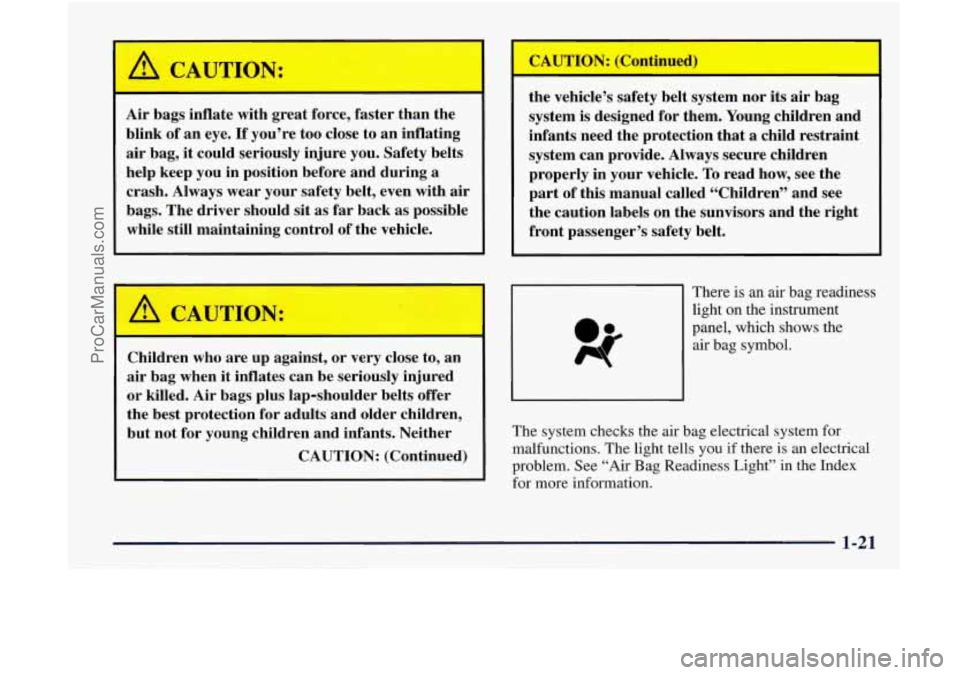
A CAUTION:
Air bags inflate with great force, faster than the
blink of an eye.
If you’re too close to an inflating
air bag, it could seriously injure you. Safety belts
help keep you in position before and during a
crash. Always wear your safety belt, even with air
bags. The driver should sit as
far back as possible
while still maintaining control of the vehicle.
/! CAUTION:
Children who are up against, or very close to, an
air bag when it inflates can be seriously injured
or killed.
Air bags plus lap-shoulder belts offer
the best protection for adults and older children,
but not for young children and infants. Neither
CAUTION: (Continued) the
vehicle’s safety belt system nor
its air bag
system
is designed for them. Young children and
infants need the protection that
a child restraint
system can provide. Always secure children
properly in your vehicle. To read how, see the
part of this manual called “Children” and see
the caution labels
on the sunvisors and the right
front passenger’s safety belt.
There is an air bag readiness
light on the instrument
panel, which shows the
air bag symbol.
The system checks the air bag electrical system for
malfunctions. The light tells
you if there is an electrical
problem. See “Air Bag Readiness Light” in the Index
for more information.
1-21
ProCarManuals.com
Page 35 of 380
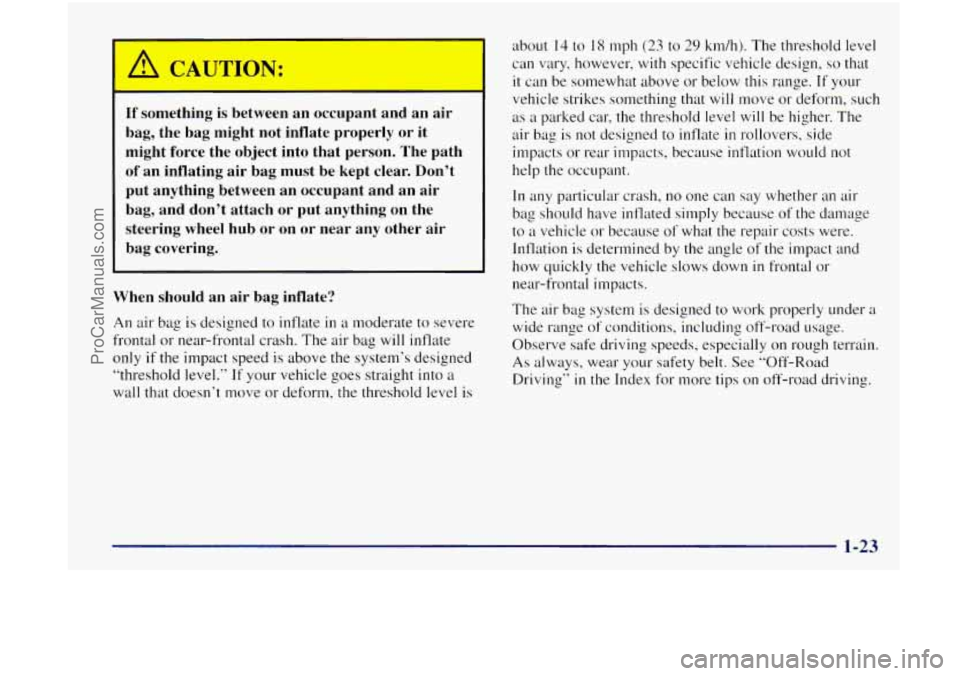
If something is between an occupant and an air
bag, the bag might not inflate properly or it
might force the object into that person. The path
of an inflating air bag must be kept clear. Don’t
put anything between an occupant and an air
bag, and don’t attach or put anything on the
steering wheel hub or on or near any other air
bag covering.
When should an air bag inflate?
An air bag is designed to inflate in a moderate to severe
frontal or near-frontal crash. The air bag will inflate
only if the impact speed is above the system‘s designed
“threshold level.’’ if your vehicle goes straight into a
wall that doesn‘t move or deform, the threshold level is about
14 to 18 mph (23 to 29 km/h). The
threshold level
can vary, however,
with specific vehicle design, so that
it can be somewhat above or below this range. If your
vehicle strikes something that will move or deform, such
as a parked car, the threshold level will be higher. The
air bag is not designed
to inflate in rollovers, side
impacts or rear impacts, because intlation would not
help the occupant.
In any particular crash, no one can say whether an air
bag should have inflated simply because of the damage
to a vehicle or because of what the repair costs were.
inflation is determined by the angle of the impact and
how quickly the vehicle slows down
in frontal or
near-frontal impacts.
The air bag system is designed to work properly under
a
wide range of conditions, including off-road usage.
Observe safe driving speeds, especially on rough terrain.
As always, wear your safety belt. See “Off-Road
Driving”
in the index for more tips on off-road driving.
1-23
ProCarManuals.com
Page 36 of 380

What makes an air bag inflate?
In an impact of sufficient severity, the air bag sensing
system detects that the vehicle is in a crash. The sensing
system triggers a release of gas from the inflator, which
inflates the air bag. The inflator, air bag and related
hardware are all part of the air bag modules inside the
steering wheel and in the instrument panel in front of the
right front passenger.
How does an air bag restrain?
In moderate to severe frontal or near-frontal collisions,
even belted occupants can contact the steering wheel or
the instrument panel. Air bags supplement the protection
provided by safety belts. Air bags distribute the force of
the impact more evenly over the occupant's upper body,
stopping the occupant more gradually. But air bags
would not help you in many types of collisions,
including rollovers, rear impacts and side impacts,
primarily because an occupant's motion is not toward
those air bags. Air bags should never be regarded as
anything more than a supplement to safety belts,
and then only in moderate to severe frontal
or
near-frontal collisions.
What will you see after an air bag inflates?
After an air bag inflates, it quickly deflates, so quickly
that some people may not even realize the air bag
inflated. Some components of the air bag module
-- the
steering wheel hub for the driver's air bag, or the
instrument panel for the right front passenger's
bag
-- will be hot for a short time. The parts of the bag
that come into contact with you may be warm, but not
too hot to touch. There will be some smoke and dust
coming from vents in the deflated air bags. Air bag
inflation doesn't prevent the driver from seeing or from
being able to steer the vehicle, nor does it stop people
from leaving the vehicle.
When an air bag inflates, there is dust in the air.
This dust could cause breathing problems for
people with a history of asthma or other
breathing trouble.
To avoid this, everyone in the
vehicle should get out as soon as it is safe
to do so.
If you have breathing problems but can't get out
of the vehicle after an air bag inflates, then get
fresh air by opening a window or door.
ProCarManuals.com